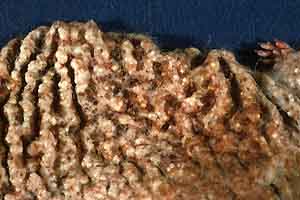Dr. Michael Goldschmidt, Diplomate, ACVP
Laboratory of Pathology, School of Veterinary Medicine
University of Pennsylvania
Philadelphia, PA 19104
|
|
|
|
|
|
|
mucosal and cutaneous, extensive | full epidermal with +/- subepidermal bullae, does not effect dermis | none or minimal except when ulcerated |
|
|
mucocutaneous, ventral neck, proximal limbs, nose, footpad | full epidermal with numerous apoptotic keratinocytes and +/- subepidermal bullae | lymphohistiocytic, perivascular and interface |
|
|
variable | coagulative necrosis extends into dermis | peripheral neutrophils and macrophages |
Contributor: Institut für Tierpathologie, Universität Bern, Länggasse 122, CH-3012, Bern, Switzerland.
Contributor's Diagnosis and Comments: Dermatitis and panniculitis (some sections), granulomatous and pyogranulomatous, multifocal and coalescing (primarily peri-adnexal), marked
Etiology: Consistent with sterile granuloma and pyogranuloma syndrome (idiopathic peri-adnexal multinodular granulomatous dermatitis).
Sterile granuloma and pyogranuloma syndrome is a disorder seen not uncommonly in the dog associated with multiple, firm, well-demarcated alopecic nodules generally involving the muzzle region. Some breed predilection is noted (great Dane, boxer, English bulldog, dachshund, golden retriever) but any breed may be affected. Age and sex predilections have not been observed. Some lesions regress spontaneously, while others may wax and wane. Associated clinical signs are generally not apparent. Several histopathological subtypes have been described. Differential considerations include infectious processes (bacterial and fungal), that can be ruled out via culture and special stains, foreign body reaction and variations of cutaneous histiocytosis. The condition is idiopathic, but the histiocytic inflammatory response in conjunction with the often marked clinical response to glucocorticoid therapy suggests the likelihood of an immune dysfunction, possibly associated with persistent antigenic drive.
Conference Note: Sterile granuloma and pyogranuloma syndrome (SGPS), idiopathic peri-adnexal multinodular granulomatous dermatitis (IPMGD) and cutaneous histiocytosis share many clinical and histopathologic features. They may represent different manifestations of the same disease. Based on the deep infiltration, frequent mitoses, angiocentricity and absence of distinct granulomas, we favor cutaneous histiocytosis over the other conditions in this case. SGPS and IPMGD are usually dramatically responsive to glucocorticoids. While lesions of cutaneous histiocytosis may regress spontaneously and some respond well to immunosuppressive therapy, most are slowly progressive and warrant a guarded prognosis.
Special stains for bacteria and fungi (Brown and Brenn, Brown and Hopps, GMS) performed at the Armed Forces Institute of Pathology did not reveal infectious agents.
Gross Pathology: Submitting clinician described ulcerative skin lesions.
Visceral leishmaniasis is a disease of humans and members of the Canidae family. In the Middle East, leishmaniasis is caused by L. infantum; the vector is the sandfly Phlebotomus sp. and the reservoir is mainly dogs. Visceral leishmaniasis is a fatal zoonotic disease if the patient does not receive the proper treatment. Classical visceral leishmaniasis in dogs appears as a chronic wasting disease with anemia, generalized lymphadenopathy and skin lesions.
The most common findings in cutaneous lesions are hyperkeratosis with massive scaling and ulcerative dermatitis with massive infiltration of mainly histiocytes in which the amastigote form of Leishmania sp. can be found.

Gross Pathology: The animal has an armadillo appearance, with thick concentric folds forming large rings over the trunk and thorax, starting at the tail and smoothing out somewhat toward the neck. Large folds are also found in the axillary and perineal areas. Hair loss appears complete over most of the body, but there is still some dark grey fuzz on the dorsocranial neck, face, proximal tail and proximal forelimbs. Yellow brown, abundant crust fills the folds between the thick rings of skin, especially on the back. Hundreds of pearlescent nodules, most 2-4 mm in diameter, are scattered in the skin of the abdomen and thorax. The face, ears and lips also have many nodules. Fewer nodules are found in the skin of the limbs, and the tail and pads appear unaffected. The animal has little body fat. The adrenal glands appear grossly normal. The thyroid glands appear slightly small.
1 - moderate Staph coagulase negative, 2 colony types.
2 - few Escherichia coli.
3 - rare diphtheroid.
Contributor's Diagnoses and Comments: Cystic keratin dilatation of follicular infundibula, and possibly of sebaceous ducts as well; epidermal hyperplasia with orthokeratotic hyperkeratosis; mild chronic dermatitis.
Conference Note: Spontaneous mutations resulting in hairless mice have been recognized since the mid 1800's, and new mutations with similar gross and histologic features continue to arise. The hairless locus is on chromosome 14. Two hairless alleles are recognized, the hairless (hr) and the hairless rhino (hr-rh). Other mutations related to hair loss include naked (N), ragged (Ra), nude (nu), asebia (ab), and ichthyosis (IC).
Captain, United States Army
Registry of Veterinary Pathology*
Department of Veterinary Pathology
Armed Forces Institute of Pathology
(202)782-2615; DSN: 662-2615
Internet: estep@afip.osd.mil